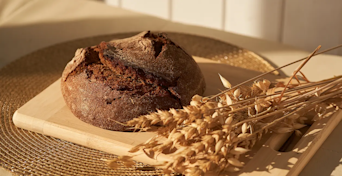🔥 Bestseller

All our favorite products
Error: Missing content
Our most popular meals, drinks, and bars
Free t-shirt, shaker and cup
From $100
0
2
With millions suffering from gluten intolerances and celiac disease, our awareness of gluten has risen substantially in recent years. But do you know what it actually is, how it can affect some people, and what gluten-free really means? Our nutrition team answers some of the most frequently asked questions on the topic.
Gluten refers to a group of proteins that are found in some, but not all, grains. These grains include wheat, barley, rye and triticale (a cross between wheat and rye). The two main gluten proteins are called gliadin and glutenin.
Gluten is essential for giving baked goods their structure and texture. The proteins gliadin and glutenin work together to form a flexible network that traps air, allowing dough to rise and hold its shape during baking. This is what creates the chewy texture found in bread and pastries. When water is added to flour, gluten forms a network that retains moisture. Gliadin helps dough rise by trapping air during fermentation, while glutenin provides strength and elasticity.[2] The more the dough is mixed, the stronger the gluten network becomes, which results in a chewier texture, ideal for bread but less so for cakes. Without gluten, the desirable qualities of many baked goods are lost, and replicating this network with alternative ingredients can be challenging.[3]
Celiac disease is a chronic autoimmune condition[4] where the body treats gluten as a threat, triggering an immune response that causes inflammation and damage to the small intestine. Symptoms include gut issues, fatigue, joint pain, and micronutrient deficiencies, such as iron[4]. Since symptoms can be general, celiac disease may go undiagnosed[5]. If you or a family member experience these symptoms, it’s important to get a screening for a proper diagnosis.
Non-celiac gluten insensitivity (also known as gluten intolerance) occurs when an individual experiences symptoms like intestinal distress, headaches, and fatigue from consuming gluten but has not been diagnosed with celiac disease or a wheat allergy. While some symptoms overlap[6], self-diagnosis does not confirm gluten sensitivity, and many individuals who self-diagnose may actually have other dietary issues or no issues at all. Research shows only about 7% of those self-diagnosed with gluten sensitivity have symptoms related to gluten[8].
Dermatitis herpetiformis is another gluten-related autoimmune condition, often linked to celiac disease, though it affects a small portion of the population (about 0.03%)[9].. It is characterized by itchy blisters or rashes, typically on the elbows, knees, and buttocks.[10].
While both celiac disease and non-celiac gluten sensitivity can cause digestive discomfort, celiac disease involves an autoimmune response that damages the small intestine, while non-celiac gluten sensitivity lacks this damage and has no clear diagnostic criteria, making it more difficult to identify and manage.
It depends on the individual. If you have celiac disease, wheat allergy, or non-celiac gluten sensitivity, then the answer is no. Around 1% of the population suffer from celiac[11]. The number of people with non-celiac gluten sensitivity is likely higher in the general population, however, due to self-diagnoses and lack of medical consultation, there is considerable debate around the number of people affected by non-celiac gluten sensitivity [12]. The average figure appears to be approximately 6%[13]. If you do not have any of the aforementioned conditions, then you do not need to avoid gluten. If you feel you might, it is important to get a professional medical diagnosis. Additionally, a dietitian will be able to ensure your diet and health do not suffer as a result of avoiding certain foods.
Beyond managing gluten-related disorders, the answer is no. A gluten-free diet can have negative consequences as a result of dietary restriction. It has been shown to result in an inadequate intake of fibre and magnesium, along with several other micronutrients[14, 15] and an increase in sugar consumption[16]. People who follow a gluten-free diet may well have a nutritious diet, however, it’s important to understand that eliminating certain foods does not automatically make a diet more nutritious. The reason that a gluten-free diet can have such consequences is that some gluten-free products may be higher in sugar and fat while being low in wholegrains[17].
Furthermore, gluten-free alternatives tend to be over twice as expensive as their gluten-containing counterparts[18] while being of a lower quality, particularly in terms of texture[17].
It’s hard to define what a fad diet is, without pointing to examples, even though the term has existed for over 100 years[19]. If someone is looking towards a gluten-free diet to improve the quality of their diet or for weight loss, then eliminating gluten is unlikely to help directly.
For those who must avoid gluten because of a dietary condition, it is certainly not a fad. The increase in media coverage of “gluten-free” has improved the availability and variety of gluten-free options[20]. It has also made “gluten-free” a more present sign on food labels. On the other hand, it has created more confusion around what celiac disease is and how that differs from those who choose not to eat gluten for other reasons[20].
Most foods are gluten-free. This includes meat, poultry, nuts, seeds, dairy, fruit, and vegetables. Although the most commonly consumed grains contain gluten, not all do. Some examples of gluten-free grains are corn, oats, buckwheat, and quinoa. It’s important to note that grains naturally free of gluten may become contaminated during growing or processing if they come into contact with gluten-containing grains.
Processed foods can contain gluten when you may not expect them to, such as soy sauce. Although the labeling of gluten-free foods is not required there are laws surrounding it. A food can only be labelled as gluten-free if it contains 20ppm or less[21].
Gluten-free foods are produced in controlled environments to prevent contamination with gluten-containing ingredients. This involves using dedicated facilities or separate production lines, along with rigorous cleaning protocols. After harvesting, ingredients must be transported, handled, and packaged in gluten-free areas, which may require separate factories or distinct parts of the same facility, ensuring no cross-contact with gluten. Additionally, thorough cleaning and time (over 24 hours) between handling gluten and gluten-free ingredients are crucial.
To maintain gluten-free standards, crops must be grown in separate, controlled environments to prevent contamination from neighbouring fields. Once harvested, ingredients like tapioca, rice, or corn flour can replace gluten-containing flours. Other ingredients, such as emulsifiers, fibres, and hydrocolloids, may be added to replicate the texture and structure of gluten-containing foods, ensuring the final product maintains its desired properties.[17].
Oats are naturally gluten-free. However, as mentioned above, they are an example of a grain that can become contaminated with gluten. As a result, oats are often certified as suitable for people with celiac disease by being grown and processed in a gluten-free environment (22). Around 8% of those with celiac disease appear to react to gluten-free oats (23). This may be due to avenin. Avenin is another prolamin protein similar in structure to gluten, which can cause an autoimmune response.
Huel offers a range of gluten-free products, including the Black Edition powder, Ready to Drink, Complete Protein, Huel Powder v3.1, Daily Greens, and some Instant Meals. The Black Edition powder is made without oats, making it a great option for those with oat sensitivities. Some gluten-free products such as the Huel v3.1 powder and Ready to Drink are made with gluten-free oats. All gluten-free Huel products are batch tested and confirmed to contain less than 20ppm of gluten.
Biesiekierski JR. What is gluten? Journal of gastroe
nterology and hepatology. 2017; 32 Suppl 1:78-81.
Barak S, et al. Influence of Gliadin and Glutenin Fractions on Rheological, Pasting, and Textural Properties of Dough. International Journal of Food Properties. 2014; 17(7):1428-38.
Bunning F. Gluten-Free Baking. 2017. Available from: https://routt.extension.colostate.edu/wp-content/uploads/sites/4/2018/05/9.376-Gluten-Free-Baking.pdf.
NIH. Celiac disease. Date Accessed: 10/30/19. [Available from: https://ghr.nlm.nih.gov/condition/celiac-disease]
Rubio-Tapia A, et al. Increased prevalence and mortality in undiagnosed celiac disease. Gastroenterology. 2009; 137(1):88-93.
Leonard MM, et al. Celiac Disease and Nonceliac Gluten Sensitivity: A Review. Jama. 2017; 318(7):647-56.
Biesiekierski JR, et al. No Effects of Gluten in Patients With Self-Reported Non-Celiac Gluten Sensitivity After Dietary Reduction of Fermentable, Poorly Absorbed, Short-Chain Carbohydrates. Gastroenterology. 2013; 145(2):320-8.e3.
Lionetti E, et al. Re-challenge Studies in Non-celiac Gluten Sensitivity: A Systematic Review and Meta-Analysis. Frontiers in Physiology. 2017; 8(621).
West J, et al. Incidence and prevalence of celiac disease and dermatitis herpetiformis in the UK over two decades: population-based study. The American journal of gastroenterology. 2014; 109(5):757-68.
National Institute of Diabetes and Digestive Kidney Disease. NIH. Dermatitis Herpetiformis. Date Accessed: 10/30/19. [Available from: https://www.nid
dk.nih.gov/health-information/digestive-diseases/dermatitis-herpetiformis]
Singh P, et al. Global Prevalence of Celiac Disease: Systematic Review and Meta-analysis. Clinical gastroenterology and hepatology: the official clinical practice journal of the American Gastroenterological Association. 2018; 16(6):823-36.e2.
Catassi C, et al. Non-Celiac Gluten sensitivity: the new frontier of gluten-related disorders. Nutrients. 2013; 5(10):3839-53.
Sapone A, et al. Spectrum of gluten-related disorders: consensus on new nomenclature and classification. BMC Medicine. 2012; 10(1):13.
Tavakkoli A, et al. Characteristics of patients who avoid wheat and/or gluten in the absence of Celiac disease. Digestive diseases and sciences. 2014;
59(6):1255-61.
Vici G, et al. Gluten free diet and nutrient deficiencies: A review. Clinical nutrition (Edinburgh, Scotland). 2016; 35(6):1236-41.
Wild D, et al. Evidence of high sugar intake, and low fibre and mineral intake, in the gluten-free diet. Alimentary pharmacology & therapeutics. 2010; 32(4):573-81.
El Khoury D, et al. A Review on the Gluten-Free Diet: Technological and Nutritional Challenges. Nutrients. 2018; 10(10).
Missbach B, et al. Gluten-free food database: the nutritional quality and cost of packaged gluten-free foods. PeerJ. 2015; 3:e1337-e.
Diet and Diet Fads. The Hospital. 1908; 45(1160):173-4.
King JA, et al. Experiences of coeliac disease in a changing gluten-free landscape. Journal of human nutrition and dietetics: the official journal of the
British Dietetic Association. 2019; 32(1):72-9.
FDA. Questions and Answers: Gluten-Free Food Labeling Final Rule. Date Accessed: 10/30/19. [Available from: https://www.fda.gov/food/guidanceregulation/guidancedocumentsregulatoryinformation/allergens/ucm362880.htm#Gluten_Levels]
Gilissen LJWJ, et al. Why Oats Are Safe and Healthy for Celiac Disease Patients. Medical sciences (Basel, Switzerland). 2016; 4(4):21.
Hardy MY, et al. Ingestion of oats and barley in patients with celiac disease mobilizes cross-reactive T cells activated by avenin peptides and immuno-dominant hordein peptides. Journal of Autoimmunity. 2015; 56:56-65.
Get 15% off your first order, plus insider access to expert tips, exclusive discounts, and the latest from Huel.
This site is protected by reCAPTCHA and the Google Privacy Policy and Terms of Service apply. You can unsubscribe at any time. Huel Privacy Policy.

